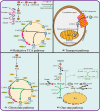Recent advances in producing food additive L-malate: Chassis, substrate, pathway, fermentation regulation and application
- PMID: 36604311
- PMCID: PMC10034640
- DOI: 10.1111/1751-7915.14206
Recent advances in producing food additive L-malate: Chassis, substrate, pathway, fermentation regulation and application
Abstract
In addition to being an important intermediate in the TCA cycle, L-malate is also widely used in the chemical and beverage industries. Due to the resulting high demand, numerous studies investigated chemical methods to synthesize L-malate from petrochemical resources, but such approaches are hampered by complex downstream processing and environmental pollution. Accordingly, there is an urgent need to develop microbial methods for environmentally-friendly and economical L-malate biosynthesis. The rapid progress and understanding of DNA manipulation, cell physiology, and cell metabolism can improve industrial L-malate biosynthesis by applying intelligent biochemical strategies and advanced synthetic biology tools. In this paper, we mainly focused on biotechnological approaches for enhancing L-malate synthesis, encompassing the microbial chassis, substrate utilization, synthesis pathway, fermentation regulation, and industrial application. This review emphasizes the application of novel metabolic engineering strategies and synthetic biology tools combined with a deep understanding of microbial physiology to improve industrial L-malate biosynthesis in the future.
© 2023 The Authors. Microbial Biotechnology published by Applied Microbiology International and John Wiley & Sons Ltd.
Conflict of interest statement
The authors declare that they have no conflict of interest.
Figures



References
-
- Ahn, J.H. , Jang, Y.S. & Lee, S.Y. (2016) Production of succinic acid by metabolically engineered microorganisms. Current Opinion in Biotechnology, 42, 54–66. - PubMed
-
- Battat, E. , Peleg, Y. , Bercovitz, A. , Rokem, J.S. & Goldberg, I. (1990) Optimization of L‐malic acid production by aspergillus flavus in a stirred fermentor. Biotechnology and Bioengineering, 37, 1108–1116. - PubMed
-
- Battat, E. , Peleg, Y. , Bercovitz, A. , Rokem, J.S. & Goldberg, I. (2010) Optimization of L‐malic acid production by aspergillus flavus in a stirred fermentor. Biotechnology and Bioengineering, 37, 1108–1116. - PubMed
Publication types
MeSH terms
Substances
LinkOut - more resources
Full Text Sources

